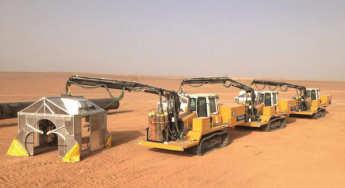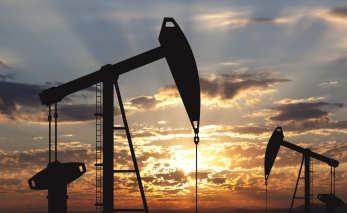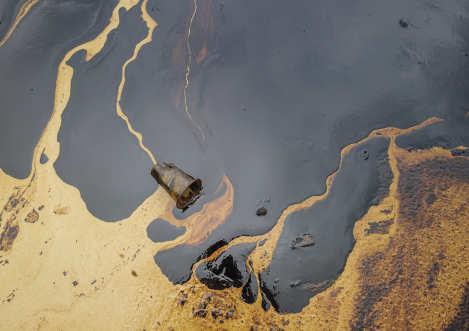
10 minute read
6th Oil & Gas Africa
Table3: New Crude Oil Projects in Nigeria
led by Shell Nigeria Exploration & Production Co. (SNEPCO) ties into the existing Bonga vessel, one of the world’s largest floating production, storage and offloading (FPSO) vessels. BSWA (the first large project since 2019) will have a capacity of 150,000-200,000 bpd – expected online 2022.
The US$13.5bn Ultra-deepwater Zabazoba-Etan project (depths ranging from 1,200-2,400 metres) is jointly developed by ENI and SNEPCO and has estimated total reserves of 560mn barrels of oil equivalent. The first output from integrated oil-gas fields is expected in late2021. Oil produced from the Zabazoba field will be transferred to FPSO and offloaded onto tankers and crude vessels.
Total’s Egina field in water depths of (4,593-5,577 ft) was the last major offshore project online that reached a peak production plateau of 200,000bpd at end2019, with estimated reserves of 570mn barrels. About 44 subsea wells were drilled and connected, via umbilical and risers, to an FPSO designed to hold 2.3mn barrels of oil.
The Assa North/Ohaji South (ANOH) project led by Seplat Petroleum Development and Nigerian National Petroleum Corp; (NNPC) is among the seven gas production infrastructures underway. It will process ‘wet gas’ which, once fully onstream, boast a capacity of 1.2bn scf per day. The ANOH project is a vital gas supply hub in Nigeria’s burgeoning gas infrastructure network.
The revamp of the legal, economic and governance framework of the oil industry should help ensure production growth due in the mid-2020s remains on track. Fitch Solutions said, “Existing discoveries of sizeable reserves are a most likely area of new investment as several are noted as a pre-final investment decision (FID projects) in various companies’ most recent filings.” Fiscal changes under the PIA are favourable, cutting taxes levied on operators to more globally competitive levels, with production royalties now ranging from (5% to 15%) depending on fields locations, down from previously (7.5% to 20%).
Name
Qualbo
Operator Location Production plateau Est. start date (000, bpd)
NNPC onshore 90 2021
Zabazoba-Etan ENI deepwater 120
Bongo Southwest Aparo Shell Preowei (OML) Total deepwater 225 deepwater 50
Owowo ExxonMobil deepwater 160 2021 2022 2023 2024
Sources: U.S. Energy Information Administration & co. websites.
Cautions over new targets
Few observers, however, remain sceptical of Nigeria’s ambitions to double oil output by 2025 mainly due to instability in the Niger Delta, where oil theft/spills from pipelines long affected IOCs – hence not conducive for the upstream investment climate. Crude oil losses due to theft/sabotage totalled 42.25mnbpd in 2019, valued at US$2.77bn at an average price of US$65.61/barrel according to figures from the Nigeria Extractive Industries Transparency Initiative (NEITI).
“Nigeria has not met a single production target for at least a decade now, in many cases because of security concerns,” noted political risk analysis firm, SBM Intelligence. Previously, Nigeria set the target of 2020 and later, 2023 to raise its crude reserves to 40bn barrels and output to three mnbpd. Maikanti Baru, group managing director NNPC, admitted our target is aggressive but “Nigeria is committed to meeting it.”
Nigeria also faces competition from the likes of Angola, Brazil, Kazakhstan, plus newcomers Guyana and Suriname for new (E&D) investment. Fitch Solutions believes global capex is likely to decline over the longer-term, as decarbonisation efforts divert more capital to alternative energy and high margin barrels.
Table2: Nigeria's Natural Gas Output (billion cubic metres)
(%) Africa Total
2018
48.3 20.0
2019
49.3 20.2
2020
49.4 21.3
Proved Gas Reserves (end-2020)
193.3 Tcf - 42.4% of Africa's Total (455.2 Tcf), highest in the continent & 10th worldwide. Tackling domestic fuel shortages
Nigeria’s ambitions also extend to its downstream sector with aims of tripling refining capacity to 1.52 mnbpd by 2025, thereby becoming ‘self-reliant’ in fuels, according to NNPC. Presently, the operating refineries with a total processing capacity of 445,000 bpd struggle to achieve full capacity due to the underinvestment in maintenance. The federal government is working with private operators to help curb costly refined fuel imports.
The 650,000 bpd Dangote refinery (due online 2022) will secure the bulk of the capacity hike. This mega integrated refinery/petrochemical complex (estimated cost US$18bn) will also produce 4.6mn tonnes (mt) of diesel; four mt of jet fuel; 0.69 mt of polypropylene; 0.24 mt propane; 32,000 mt sulphur and 0.5 mt carbon black feed –making it the world’s biggest single-train facility – with high potential for refined petroleum exports.
Conclusion
Nigeria is optimistic about reviving its underperforming oil sector. However, a crucial question is whether the “landmark” PIA will prove ground-breaking legislation for new investment. The Federal government is eager for a greater influx of foreign capital, but only time will tell whether IOCs are willing to invest ‘big’ in Nigeria over the coming decade. Private investments are crucial to achieving optimal hydrocarbons potentials. Besides competitive fiscal terms, funding to upgrade ageing midstream infrastructure (pipelines) and improved security for onshore operations are equally crucial to win back investment.
Africa’s biggest crude oil supplier offers prolific opportunities in deepwater oil-gas exploration and production for foreign energy majors over the coming years.
Digital oilfield technologies to be gamechanger s in upstream oil and gas
THE PANDEMIC HAS been a wake-up call to the upheaval that a sudden drop in energy demand and/or labour availability can cause, and digital oilfield technologies such as digital twins and other remote monitoring solutions are seen to be gamechangers in upstream oil and gas operations, according to GlobalData.
Charlotte Newton, analyst on the thematic research team at GlobalData, commented, “Technologies such as digital twins have the potential to be the backbone of digitalisation in the sector. By creating 3D images and simulations of assets, systems, and processes, oil companies can imagine more sophisticated, and more reliable, machinery in oilfields both now and in the near future.”
Ravindra Puranik, oil and gas analyst at GlobalData, added, “The oil and gas (O&G) industry saw major disruption during the first waves of the COVID-19 pandemic, and companies are now looking to automate as many processes as possible to mitigate future operational risks. This is demonstrated by the fact that contracts activity relating to digitalisation in the upstream remained resilient in the last two years, despite the pandemic-led industry downturn.”
Operators in southeast Asian fields are also deploying digital oilfield technologies. There has been activity in the Oceania and Western Africa regions, which may gain momentum with improvement in energy prices.
Maats Pipeline Professionals features high quality equipment for pipeline construction
THE NETHERLANDSBASED MAATS Pipeline Professionals has featured its varied range of high quality equipment for the construction of pipelines.
Maats Pipeline Professionals focuses on sales and rental of new and used high quality equipment for the construction of pipelines with all common diameters.
For nearly 40 years, Maats is one of the leading suppliers and manufacturers of pipeline construction equipment and services to the pipeline industry.
Maats supplies a wide variety of specialised construction machinery such as pipelayers, welding tractors, bending machines and related equipment for new pipeline construction as well as for pipeline maintenance and repair. Maats produces high quality pipeline equipment under its own label.
Renting equipment helps to avoid the burden of excessive investment, maintenance and other costs, and it provides the operators with the equipment when the operator needs it.
“The machines in our rental fleet are available for short, medium and long term rental. Not to be ignored these days is that rental minimises environmental impact,” stated Maats.
Rental at Maats gives permanent access to the most modern and efficient fleet of equipment globally available. The company's equipment is regularly maintained by its own team of engineers ensuring customers have high quality and reliable equipment on site.
One of Maats’ primary objectives is to supply its customers with the specialised equipment they need for the construction of pipelines.
Image Credit: Maats Pipeline Professionals
Sound Energy enters gas sale agreement over Tendrara second phase in Morocco
SOUND ENERGY, THE energy transition company, has announced that material progress has continued to be made towards satisfying the remaining conditions precedents to the Phase 1 LNG Gas sales Agreement announced by the company on 29 July 2021.
The LNG GSA, in relation to the Phase 1 liquified natural gas based development of the company's Tendrara Production Concession, is in addition to the Phase 2 development gas sales agreement announced by the company on 30 November 2021 in relation to the wider, pipeline based, development plan.
Sound Energy has now satisfied all CPs within its direct control and the material remaining CP to the LNG SPA not currently satisfied relates to the entry of the loan note agreement with Afriquia Gaz described in the company's announcement of 29 July 2021. Other CPs not satisfied by the date on which the Loan Note Agreement is entered as currently expected to be waived.
Graham Lyon, Sound Energy's executive chairman, commented, “Much work has been completed in the last month and contracts finalised with Ital Fluids.”

Image Credit: Adobe Stock
MANAGE THE DAMAGE FROM SPILLS
The United Nations Environment Programme (UNEP) explores the dire impact of oil spills, the cost of clean-ups and what can be done to limit damage to the environment and ecosystems.
THE OCTOBER OIL spill in California and the sinking of the X-Press Pearl off the coast of Sri Lanka in July have renewed attention on the environmental dangers of such disasters, especially the toll they take on marine and coral life.
According to UNEP, there are many types of oil spills and most are minor, for example when oil spills from a ship when it is being refuelled. But serious incidents, such as the 2020 oil spill in Mauritius, bring consequences that can be felt for decades. Most of the major oil spills happen when a pipeline breaks, a tanker sinks or runs aground or when a drilling operation goes wrong.
The oil spills have huge financial impact. “Not only does the clean-up have to be paid for, and in the cases of big spills this can run into billions of dollars, but the long-term impact of a spill also has an economic consequence. If, for example, like in Sri Lanka, the spill is in an area of outstanding natural beauty tourist numbers often decline, if the area is reliant on fishing, this often must be halted while the area recovers,” explained UNEP.
Preparing for future oil spills
Governments and the oil industry must have preparedness plans in place and understand what to do when an oil spill happens. Equally important is conducting regular spill response training exercises. The quicker and better prepared the reaction the less the environmental impact. Oil spill response can be tiered so that small spills are handled at a local level, larger spills are handled on a national level and major spills call on an international response. clean-up crew to get to the site of the spill, the weather conditions, type of oil, shoreline type and environmental sensitivity amongst other factors. If a crew can reach a spill in a few hours, they can aim to contain and skim the oil.
Once the oil reaches the shoreline or spreads out it becomes harder to clean up. When oil gets close to the shoreline, manual clean-up campaigns are typically deployed, while floating dummies and balloons are used as a deterrent to get wildlife away from the impacted areas.
However, no solution completely removes the oil, in the best case scenario, only 40% of oil from a spill can be cleaned up by mechanical means. The ability of natural recovery to restore the environment can play an important role, and the actions to enhance its effectiveness need to be considered.

Restoring an area impacted by an oil spill is crucial to recovery.
Image Credit: Adobe Stock
Restoration after an oil spill
Restoring an area impacted by an oil spill is crucial to recovery. Before restoration can begin an understanding of the damage done by the spill needs to be undertaken, this is done through continued ecological, biological and chemical studies and analysis.
Once the damage is understood steps can be taken to accelerate the recovery, particularly those enhancing natural processes. Restoration can include the reintroduction of species affected by the spill, erosion control, if damage from the spill has sped up erosion, and a change in management practices, such as controlling fishing and hunting, in impacted areas.
To view the full article and links to further resources, see https://www.unep.org/news-andstories/story/how-manage-damage-oil-spills




